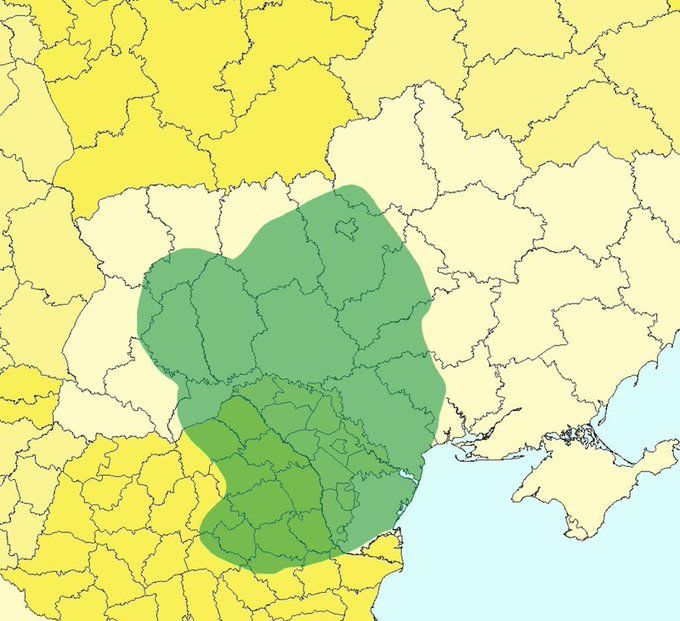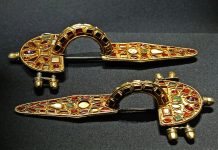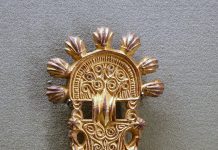In the 1890s, while excavating an Upper Paleolithic site in central Kyiv, Czech archaeologist Vikenty Khvoika discovered artifacts of a later civilization. The pieces of pottery covered with ornamentation Khvoika found at the Kyiv site led him to Trypillia village located some 50 kilometers south of Kyiv and also situated on the Dnieper River banks. V. Khvoiko named the civilization he discovered after the name of that village. What he unearthed at that village shook the scientific world and made many historians review their notions and ideas. British academic and archaeologist whose studies focused on Eastern Europe Dr. Ellis Minns mentioned Khvoiko in his famous work published in 1918 stating that ‘close by the paleolithic station at Cyril Street, Kyiv, Chvojka investigated the most important neolithic site…” At the Trypillia site, Khvoiko found spindle whorls which indicated that spinning and weaving were known to the inhabitants of the village. The inhabitants also made weapons and tools of flint and horns of deer and elk. Interestingly, the ancient settlers seem to have kept tortoises as pets. But the most characteristic was the pottery, in which, according to E. Minns, the progress could be traced from “very ill-baked, formless, cracked vessels, made of the first earth that came to hand… to fairly graceful pots of considerable size, adorned with dots and lines and made of a careful mixture of clayey sand and pounded shells.” It was Trypillian pottery that became the sensation and E. Minns wrote the following: “Amid the clay lumps, standing or lying or upside down on the original floor, are the remarkable vessels that give chief interest to the discovery, as in them and the figures some have seen an analogy to the early Aegean culture. As many as eighty have been found together”.
E. Minns described the reaction of his colleagues as well: ” Those who studied the Western regions, where somewhat similar spirals occur, did not at first dare to think that northerners could have been so artistic without external influence, and ascribed the highly developed decoration to the influence of the Aegean exercised through traders and the importation of wares. Independently M. Much, H. Schmidt, and von Stern advanced the view that the movement was the other way, that the northern finds are earlier in date than the similar objects in the Aegean region—in fact von Stern… thinks that the artistic people who made the Petreny pots moved south and conquered even as far as Crete. The difficulty here is that we can trace back continuous development on such sites as Cnossus to a neolithic stratum far inferior in artistic power to the pots at Petreny: that is, that the supposed northern immigrants must have gone back in their art on reaching new countries, and afterwards raised it again to the height of Kamares ware or ware from Phylakopi which according to von Stern recall Tripolje and Petreny. This is of course possible; the wars of conquest may have caused a setback in art”.
The ‘Settlements of the Cucuteni-Trypilla culture‘ Wikipedia page says the following: “The latest research (2014) suggests that some of the largest mega sites contained as many as 3,000 structures and with the possibility of 20,000 to 46,000 inhabitants. Maidanets may have contained almost 3,000 houses and a population of anything between 12,000 and 46,000 with 29,000 as the average population figure. Dobrovody and Talianki are estimated with populations of up to 16,200 and 21,000.
In terms of overall size, some of Cucuteni-Trypillia sites, such as Talianki (with a population of 15,000 and covering an area of some 450 hectares – 1100 acres) in the Uman district of Ukraine, are as large as (or perhaps even larger than) the more famous city-states of Sumer in the Fertile Crescent, and these Eastern European settlements predate the Sumerian cities by more than half of a millennium.”
The ‘Cucuteni-Trypillia culture‘ Wikipedia page adds that “One of the most notable aspects of this culture was the periodic destruction of settlements, with each single-habitation site having a lifetime of roughly 60 to 80 years. The purpose of burning these settlements is a subject of debate among scholars; some of the settlements were reconstructed several times on top of earlier habitational levels, preserving the shape and the orientation of the older buildings”.
There is one more very important fact about the Trypillia Culture. Dr E. Minns states that V. Khvoika, “the first discoverer, thought that this was an autochthonous civilization developed by the Indo-Europeans before they differentiated, perhaps more particularly by that section of the race which was to become the Slavs“. Could the Ukrainians be the direct descendants of that culture? Could this possibility be the reason why Moscow tried to bury the very knowledge of Trypillia?
Watch BBC Reel “7000-year-old Civilization Silenced by Communists”
The “Cradle of Civilizations” book has more facts and insights on the topic.










